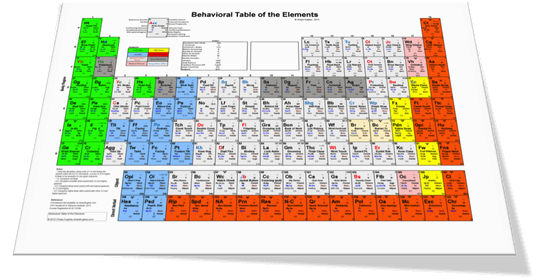Chase Hughes (@thechasehughes) created The Behavioral Table of the Elements for behavior analysis in interrogations, and is the author of The Ellipsis Manual: Analysis and Engineering of Human Behavior.
“Instead of trying to figure out what a person’s good at, try to figure out what they want to be seen as being good at and you’ll get ten times the results.” -Chase Hughes
The Cheat Sheet:
- What is The Behavioral Table of the Elements and how can we use it to determine the likelihood that someone is telling us the truth?
- Why Chase considers polygraph tests “just about as accurate as a coin toss” — and how they’re actually biased against people who tell the truth.
- What someone training to spot deception indicators and stress might learn from watching Conan O’Brien interviews.
- How training ourselves to be subconsciously aware of truth signals clues us in when someone who’s lying deviates from them.
- How to hack authority for influence and personal development.
- And so much more…
[aoc-subscribe]
Human beings lie. We lie to each other almost as much as we lie to ourselves. Sometimes we don’t even mean to do it, and often we’re deceptive without malice. But deception can also be used to hack human behavior, and we’re all more susceptible to the process than we probably realize. Whatever the reason, wouldn’t it be to our advantage to know when someone’s being deceptive toward us? Understanding nonverbal communication is crucial toward this end, but it’s still just part of the overall puzzle.
It would be a challenge to pull the wool over the eyes of today’s guest, however. Chase Hughes created The Behavioral Table of the Elements as a more accurate analysis of behavior than the much-used (and wildly inaccurate) polygraph test, and is the author of The Ellipsis Manual: Analysis and Engineering of Human Behavior. Listen, learn, and enjoy!
More About This Show
Chase Hughes literally wrote the book on tactical interrogation and behavior science — The Ellipsis Manual: Analysis and Engineering of Human Behavior — because everything he found on the subject was fragmented over multiple sources.
But the fact there had been no full-scale manual for use in the field up to this point is symptomatic of a larger negligence in the academic world. While there have been numerous studies proving the majority of information we convey to one another is done nonverbally, the importance of this revelation seems largely ignored by that world.
“I think the average psychotherapist or social worker goes through years and years of training,” says Chase. “And out of all of that, they get maybe a half hour on body language — and that’s a psychotherapist with a graduate degree. And then these are the same guys who are going out there producing studies that say [nonverbal communication makes up] two thirds or some odd number of communication — and then nothing changes in the academic perspective.”
Luckily, Chase and his team at Ellipsis Behavior Laboratories are trying to pick up the slack and expand that perspective. Currently, they’re focused on developing programs to pull the curtain back on how vulnerable the human brain is to ‘hacking’ and show (through profiling training) how vulnerable we — and the people around us — really are.
Chase hasn’t always been a model student (he tells us his parents would take him out to dinner when he’d pass a class with a C grade), but maybe it’s because nonverbal communication wasn’t a course he could pursue in school. But as soon as he found out about it, a whole, fascinating world he hadn’t known opened up to him.
“I was hooked,” says Chase. “It seemed like I was seeing…there’s something that’s been there all my life. All of this nonverbal communication has been hidden and nobody talked about it. I never knew that it was important. Once I started getting good at it, I realized you really can kind of see behind people’s masks just by reading body language.”
While becoming someone who can read body language within a slim margin of error will take hours of training and discipline that might only seem reasonable to the parents of an aspiring concert pianist, Chase and his team spent seven years developing The Behavioral Table of the Elements as an easy reference for teams reading interrogations in the field.
“The way that we use it is a cumulative read. So it doesn’t automatically mean X, Y, and Z happened. It produces a certain amount of numbers associated with each gesture so that seven interrogators can read a situation different ways, but there’s a common interpretation. You can gauge the amount of deception that’s likely taking place in an interrogation.”
Luckily for those of us who don’t regularly interrogate people, the table can be applied to any conversation. If you’re curious, you can download The Behavioral Table of the Elements from here for free — Chase encourages us to use it and “share it with the world.”
Listen to this episode of The Art of Charm to learn more about how to avoid being overwhelmed by everything there is to understand about nonverbal communication, how observation of what makes other people tick levels our own playing field, the benefit of beginning with observation and not trying to make interpretations, why The Behavioral Table is more accurate than the infamous polygraph test, what to do if we sense ourselves being behavior hacked by people who mean us harm, how we can influence physical and mental state through the posture exercise, the x-ray vision exercise that identifies what really motivates someone, and lots more.
THANKS, CHASE HUGHES!
If you enjoyed this session with Chase Hughes, let him know by clicking on the link below and sending him a quick shout out at Twitter:
Click here to thank Chase Hughes at Twitter!
Click here to let Jordan know about your number one takeaway from this episode!
Resources from This Episode:
- Transcript for Chase Hughes | The Behavioral Table of the Elements (Episode 632)
- The Ellipsis Manual: Analysis and Engineering of Human Behavior by Chase Hughes
- The Behavioral Table of the Elements
- Ellipsis Behavior Laboratories
- Chase Hughes at Twitter
- Silent Messages: Implicit Communication of Emotions and Attitudes by Albert Mehrabian
- The 7% Rule: Fact, Fiction, or Misunderstanding by Philip Yaffe, Ubiquity
- The Milgram Experiment on Obedience to Authority Figures
You’ll Also Like:
- The Art of Charm Challenge (click here or text 38470 in the US)
- The Art of Charm Bootcamps
- Elite Human Dynamics
- Best of The Art of Charm Podcast
- The Art of Charm Toolbox
- The Art of Charm Toolbox for Women
- Find out more about the team who makes The Art of Charm podcast here!
On your phone? Click here to write us a well-deserved iTunes review and help us outrank the riffraff!





